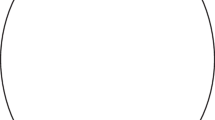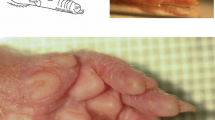Summary
The contact relationships of skin cells in late embryos and young larvae of Xenopus laevis are described. Superficial cells are joined by ‘tight’ or ‘gap’ junctions at their outer periphery but elsewhere ‘simple appositions’ are found. All-or-none impulses are evoked in the skin by electrical or mechanical stimuli (Fig. 3). Evidence is presented in favour of the view that these impulses are generated by the majority of skin cells and not by some neuronal element in the skin. The impulse propagates throughout the skin from any stimulated point (at average speed of 7.7 cm/sec) even when the animal is in distilled water. However, removal of Na+ from solutions bathing the inner skin surface or treatment with Tetrodotoxin abolishes the impulse indicating that it is Na+ dependent. Current injected into skin cells spreads to others so it is suggested that the impulse propagates by direct current flow from cell to cell. The ‘neuroid’ conduction system in the skin of Xenopus tadpoles is compared to similar systems in coelenterates and to the propagation of the vertebrate cardiac impulse.
Similar content being viewed by others
References
Bennet, M. V. L., Trinkaus, J. P.: Electrical coupling between embryonic cells by way of extracellular space and specialized junctions. J. Cell Biol. 44, 592–610 (1970).
Brightman, M. W., Reese, T. S.: Junctions between intimately apposed cell membranes in the vertebrate brain. J. Cell Biol. 40, 648–677 (1969).
Fahmy, A.: An extemporaneous lead citrate stain for electron microscopy. Proc. Electron Microscopy Soc. Am., p. 148–149. Baton Rouge: Claitor's Book Store 1967.
Farquhar, M. G., Palade, G. E.: Junctional complexes in various epithelia. J. Cell Biol. 17, 375–412 (1963).
Fatt, P., Ginsburg, B. L.: The ionic requirements for the production of action potentials in crustacean muscle fibres. J. Physiol. (Lond.) 142, 516–543 (1958).
Furshpan, E. J., Potter, D. D.: Low resistance junctions between cells in embryos and tissue culture. Curr. Top. Develop. Biol. 3, 95–127 (1968).
Goodenough, D. A., Revel, J. P.: A fine structural analysis of intercellular junctions in the mouse liver. J. Cell Biol. 45, 272–290 (1970).
Hagiwara, S., Nakajima, S.: Differences in Na and Ca spikes as examined by application of tetrodotoxin, procaine, and manganese ions. J. gen. Physiol. 49, 793–806 (1966).
Kelly, D. E.: Fine structure of desmosomes, hemidesmosomes, and an adepidermal globular layer in developing newt epidermis. J. Cell Biol. 28, 51–72 (1966).
Loewenstein, W. R.: Permeability of membrane junctions. Ann. N. Y. Acad. Sci. 137, 441–472 (1966).
Mackie, G. O.: Conduction in the nerve-free epithelia of siphonophores. Amer. Zool. 5, 439–453 (1965).
-Neuroid conduction and the evolution of conducting tissues. Quart. Rev. Biol. (in press, 1971).
—, Passano, L. M.: Epithelial conduction in hydromedusae. J. gen. Physiol. 52, 600–622 (1968).
Muntz, L.: Neuro-muscular foundations of behaviour in embryonic and larval stages of the Anuran, Xenopus laevis. Dissertation, Univ. Bristol. 1964.
Nieuwkoop, P. D., Faber, J.: Normal tables of Xenopus laevis (Daudin). Amsterdam: North-Holland Publishing Co. 1956.
Orkand, R. K., Niedergerke, R.: Heart action potential: dependence on external calcium and sodium ions. Science 146, 1176–1177 (1964).
Parker, G. H.: The elementary nervous system. Philadelphia and London: Lippincott 1919.
Roberts, A.: Conducted impulses in the skin of young tadpoles. Nature (Lond.) 222, 1265–1266 (1969).
Schroeder, T. E.: Neurulation in Xenopus laevis. An analysis and model based upon light and electron microscopy. J. Embryol. exp. Morph. 23, 427–462 (1970).
Steinman, R. M.: An electron microscopic study of ciliogenesis in developing epidermis and trachea in the embryo of Xenopus laevis. Amer. J. Anat. 122, 19 (1968).
Williams, J. A.: Origin of transmembrane potentials in non-excitable cells. J. theor. Biol. 28, 287–297 (1970).
Author information
Authors and Affiliations
Additional information
Partly supported by an S.R.C. Fellowship.
Rights and permissions
About this article
Cite this article
Roberts, A., Stirling, C.A. The properties and propagation of a cardiac-like impulse in the skin of young tadpoles. Z. Vergl. Physiol. 71, 295–310 (1971). https://doi.org/10.1007/BF00298141
Received:
Issue Date:
DOI: https://doi.org/10.1007/BF00298141




